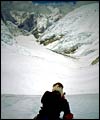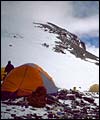The South Col route on Mt. Everest's south or Nepalese side was first reconnaisanced in 1950 by a British expedition led by Eric Shipton. Prior to that time, the Khumbu Icefall had been seen from the high glaciated pass easily accessed from the north, or Tibetan side, of Mt. Everest. It was universally considered impossible to climb by those few who had looked upon it from this high vantage point.
Then, with the Chinese invasion and takeover of Tibet, geopolitics changed and the world's highest peak was no longer accessible to the west from Tibet. Thus for the first time, Nepal allowed access to foreigners.
In 1950 the previously unthinkable happened and the Khumbu Icefall was first climbed and deemed doable but dangerous.
What exactly is an icefall? For non-climbers, a glacier can be likened to a very slow-moving river, one which is simply frozen. When a river increases its gradient, it turns into a very broken-up rapid, or cascade. When a glacier increases in gradient, it turns into an "icefall." This icefall, especially the Khumbu Icefall, is an amazingly chaotic jumble of ice blocks of all sizes. It is a place of otherworldly beautiful and improbable shapes, forms, and shades of green and blue.
It is a place of eerie silence and improbable heat as well as cold. It is also a place of continual movement. Often this movement is not perceptible, as the entire mass is moving. At other times, the movement is sudden, brutal, and has incredibly destructive consequences to everything below as literally hundreds of tons of ice blocks can give away all at once. When this happens (often several times per day in one place or another within the Icefall) everything below is reduced to nothing more than a fine, white ice powder blown away by the mountain winds. The trick is to not be in that spot as a climber.
As climbing Mt. Everest became more popular in the 1970s and thus more expeditions were on the mountain at the same time, expeditions began to cooperate with the "fixing" of the route through the Khumbu Icefall. This "fixing" means interconnecting a continuous length of ropes, thousands of feet of ropes, for safety. This allows a climber to always be connected to ropes which are in turn connected to various anchors placed into the snow or ice. This is a safeguard against falling and injury while at the same time it allows a climber to quickly move independently away from danger, something which is much more difficult and slower if one is instead roped directly to other climbers.
Along with these ropes, the terrain often requires artificial structures to bridge otherwise uncrossable ice walls or large cracks called crevasses. Most often, these artificial structures are combinations of aluminum ladder sections tied together and stabilized by a latticework of other ropes. Very impressive to behold, and often very scary to traverse!
By the 1990s, with even more climbing action taking place, there were complaints that many participant expeditions that either lacked funds or desire, were not contributing to the group "fixing" of the route. They were instead using other expeditions' hard work while contributing nothing. Therefore, over the past few years, a Nepalese governmental agency has stepped in to insure that all contribute fairly based upon the size of the expedition. The SPCC (Sagarmatha Pollution Control Committee) now oversees this. It is primarily concerned with policing expeditions and groups to control garbage properly, and so they subcontract with other people to do this actual work.
During the Alpine Ascents 2000 expedition here to Mt. Everest, this work was carried out very well and ongoing maintenance to the Icefall route was always done promptly. This year, however, has been another story.
— Willi Prittie, Alpine Ascents International Guide and MountainZone.com Correspondent
 EMAIL THIS STORY TO A FRIEND
EMAIL THIS STORY TO A FRIEND





